The Ultimate Guide for How to Grill Chicken, every single time. Follow these simple steps for a great way to get big flavor, crispy skin, and juicy texture every time (on any piece of chicken)! Stop overcooking chicken and learn the tips and tricks that pros use for juicy chicken breasts, thighs, and legs.
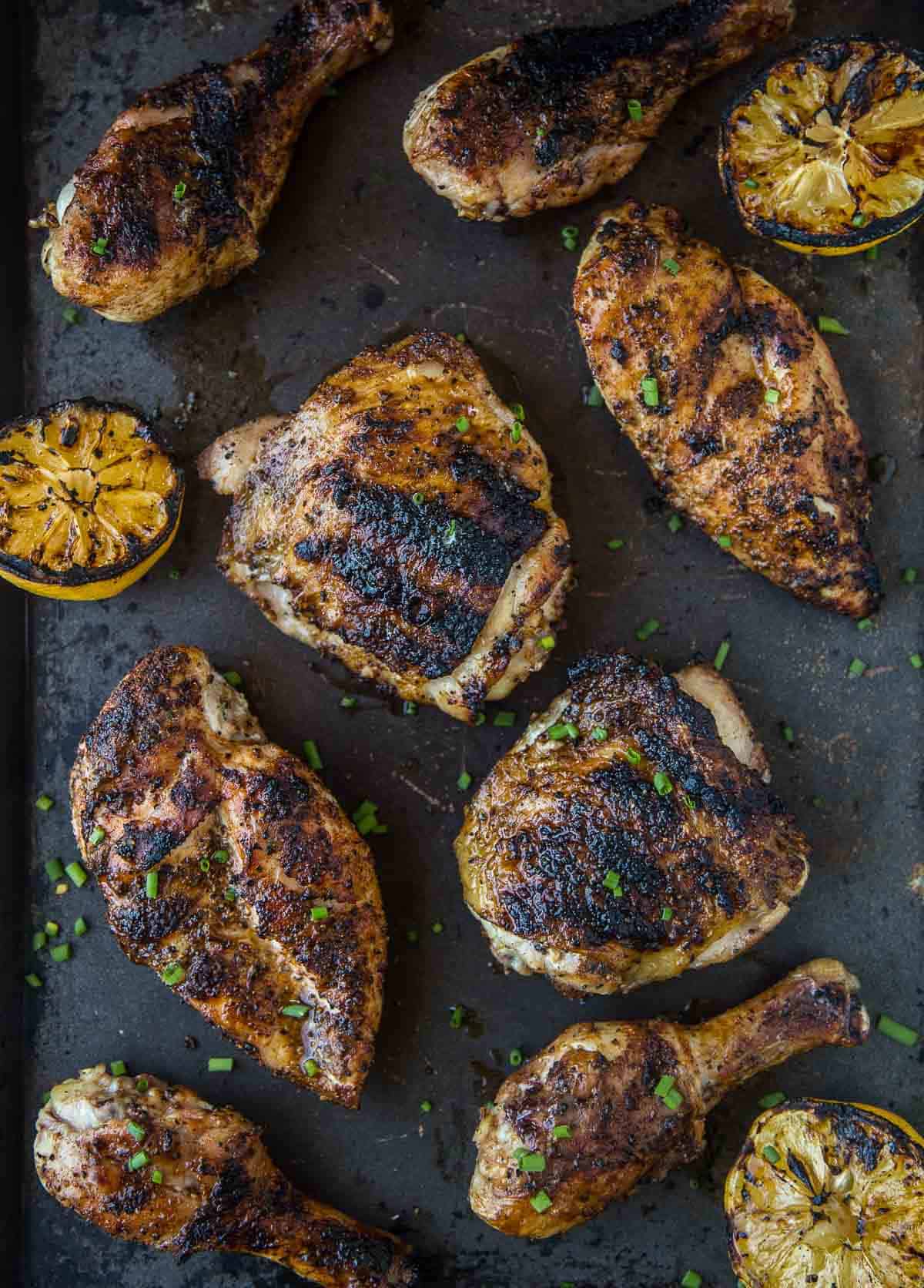
Vindulge Recipe Highlights
- Flavor starts with a simple chicken seasoning.
- To avoid overcooked chicken (dry) cook to the proper internal temperature using two-zone cooking method.
- For enhanced flavor you can use a chicken marinade or finish with a barbecue sauce glaze.
- For a grilled whole chicken be sure to follow our guide on how to spatchcock chicken and follow the same method.
Grilling chicken can be a little intimidating for people. Too often people are afraid of under-cooking chicken, which instead results in overcooked, dry, and boring chicken.
With the right seasoning, techniques, and an understanding of how to grill chicken properly, you can make fantastic flavorful chicken every time, with any cut of chicken.
Plus, we provide some great resources about understanding the right internal cooking temperature for chicken so it’s safe to eat, juicy, tender, and delicious.
[feast_advanced_jump_to]
Cuts of Chicken For Grilling
Each part of the chicken is going to cook at different times, so either buy the same cut or be prepared to rotate the different chicken around and pull them off when they are done.
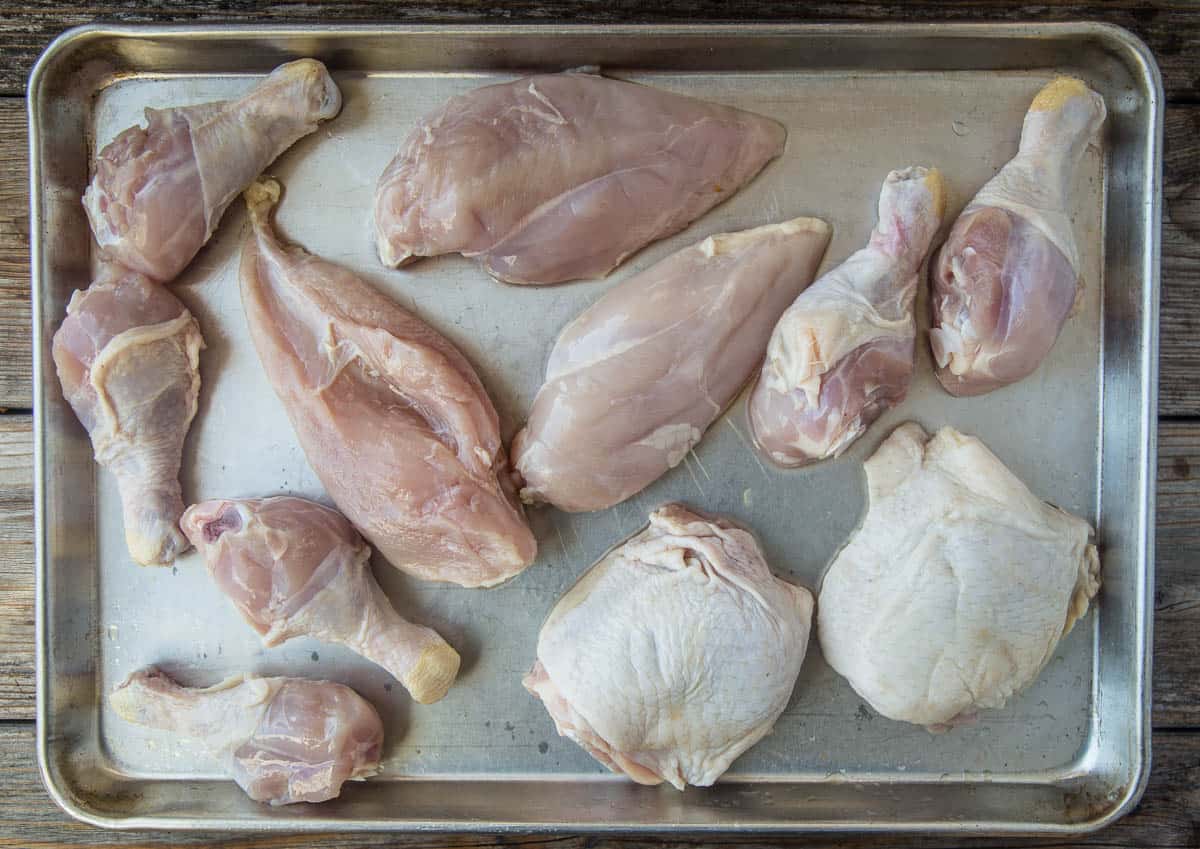
- Breast: The chicken breast is dense and with typically very little fat. It can be purchased bone-in or boneless, and also skinless or skin-on. When grilling we like bone-in and skin on.
- Thigh: The chicken thigh is the portion of the chicken between the leg and the body. It carries a lot of weight and tends to have a lot of tendon and intramuscular connective tissue. It’s delicious grilled or smoked but should be cooked to a higher internal temperature for the perfect texture.
- Leg: The chicken leg portion of the chicken grounds the chicken and has the most weight on it. One end will have all the meat where it connects with the thigh, while the other end is bone and tendons. It also is better if cooked to a higher internal temperature than a breast. We have a great recipe for grilled chicken lollipops which uses a Frenched version of the chicken leg.
Butchers Tip
The least expensive way to buy chicken is to purchase a whole chicken, which can then be butchered at home for the individual pieces. Or you can buy the chicken in parts. The less the butcher has had to cut and prepare for the case, generally speaking the cheaper the per pound price.
Skin-on Chicken or Off?
Skin-on adds a great texture to the grilled chicken. We buy skin on. But boneless skinless chicken breast follows the exact same method if that is your preference.
If you buy a whole roaster and butcher it yourself, save the bones for stock! You can find the details on our favorite smoked chicken stock in our cookbook, Fire and Wine.
Preparation and Seasoning
For all of the various pieces of chicken we are using a poultry seasoning, which has no sugar in it. Sugar can cause burning, especially brown sugar, when cooked over a high heat source. Therefore we use no added sugar in our poultry season, meant for high heat grilling. Apply olive oil to the chicken pieces and then liberally apply the seasoning. Do this first thing as your grill warms up. There is no reason to allow the meat to come to room temperature.
Our Poultry Seasoning consists of:
- kosher salt
- course ground pepper
- smoked paprika
- granulated garlic
- dried sage
- dried thyme
If you’re smoking chicken at a lower heat (i.e. low and slow cooking) we use an all purpose seasoning that does have sugar and slowly caramelizes over a longer cooking period.
Explore all of our seasoning and sauce recipes.
Grilling Method
Direct and Indirect cooking process is having the charcoal, or heat source, on one side of the grill for searing, and the other side with no charcoal or heat source. This allows the next important technique, to sear the chicken over the direct heat on your grill grates getting the crust on each side, and then moving to indirect heat to finish to the desired internal temperature. This is the key to perfect grilled chicken regardless of what cut you use.
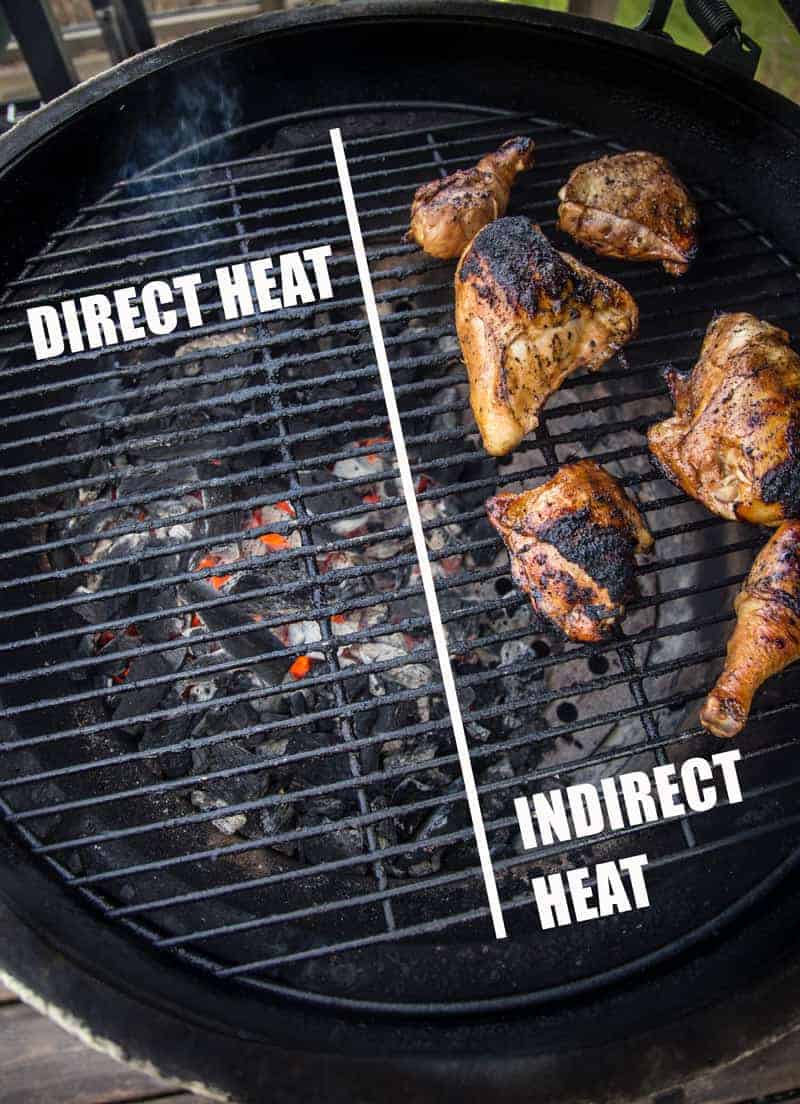
Why does the direct indirect method matter? Because as high heat sears the chicken, the fat from the chicken will render out faster and drip into the coals. This can cause flare ups that send large flames and potentially burn the chicken, creating the crusty dark burnt skin, while still having an under-cooked interior. After searing the chicken to your desired crust, moving the chicken to indirect prevents the fat from causing flare ups and roast like an oven.
Have a gas grill? Unlike a charcoal grill, you can lower the flame. That said, it is still easy to use this method with a gas grill to avoid burning the chicken, even with a lower flame.
How to Grill Chicken
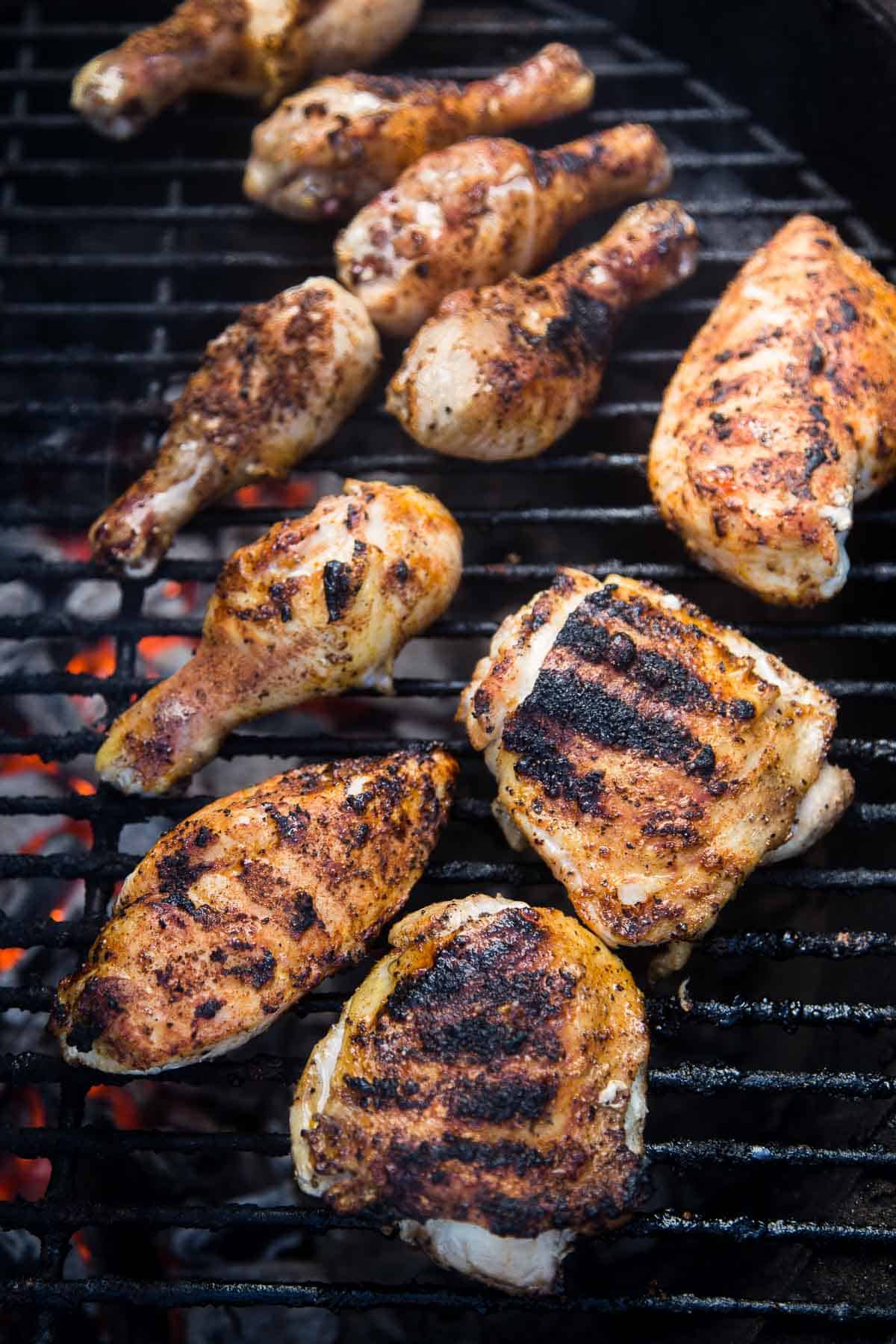
- Prepare the grill for two-zone cooking, targeting the internal temperature of the grill at 475 to 500 degrees Fahrenheit. If using a gas grill that would be medium-high heat. We prefer lump charcoal over briquettes for the combination of heat and flavor.
- Place chicken, skin side down, over the direct heat for the initial sear. Grill chicken breast for 5 minutes or until you see nice grill marks. Legs and thighs may take less time as they are smaller. Flip and grill chicken pieces for additional 5 minutes over direct heat until you get nice grill marks.
- Move the chicken to indirect heat when each piece is ready, close the lid and finish grilling until it reaches the proper internal temperature for chicken, which for us is 155 degrees Fahrenheit for the breast and 175 degrees for the legs and thighs. Let it rest to allow carry over cooking to finish cooking.
The grilling time will vary based on the thickness of the chicken breasts, and the size of the thighs and legs, which is why it’s best to cook to temperature and not time using a good instant-read thermometer.
Related Article: The perfect internal temperature of cooked chicken.
The other thing to consider is that chicken thigs and drumsticks actually have better texture if you take them to an internal temperature of 175 degrees F. This allows for a better texture because more of the intramuscular connective tissue breaks down.
Tools
In order to get the most accurate temperature you need an instant read thermometer. This is one of the key grill tools needed for anyone cooking outdoors (or indoors for that matter). Our go-to instant read thermometer for chicken is the Thermoworks Thermapen One. The probe is easy to use, it is virtually instant and most important, we can slowly move the probe through the chicken so we see the range of temperature and pull at just the right time.
The benefit of cooking separate chicken pieces is that you can take the temperature of each cut and pull each piece when it reaches the optimal temperature since each cut and each piece will finish at different times.
How To Take The Temperature of Chicken
As you pass the thermometer through the chicken, you are always using the lowest temperature as the target, and making sure to insert the probe into the center of the thickest part of the meat, but not touching bone. For an entire roaster chicken you will take the temperature in multiple locations for the most accurate read.
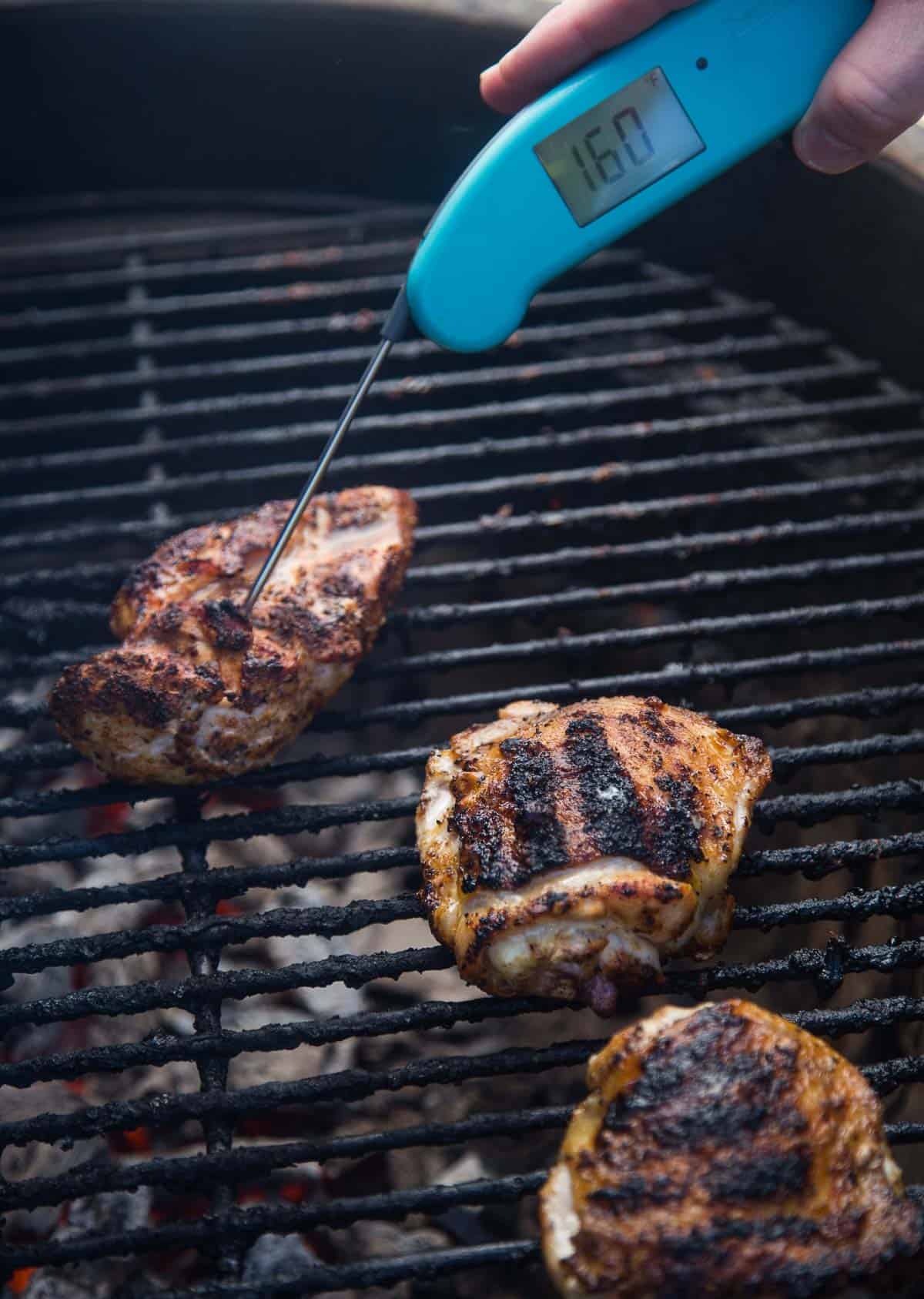
Sauces and Glazes
Glazes are simply a barbecue sauce added while cooking meat. Sauces or glazes should also be added at the end of the grilling. Why? If adding a glaze or a sauce to chicken too early, the crispy skin will absorb the liquid and get gummy and over direct heat it has a higher chance of burning.
To maintain the crispy skin and bite, add the glaze in two steps. First when the chicken is at 150 degrees F (because we are pulling at 155, for a breast that is), and then glaze a second time just after you pull the chicken off the grill and let it rest. The sauce will firm up and still keep the texture of the skin crispy.
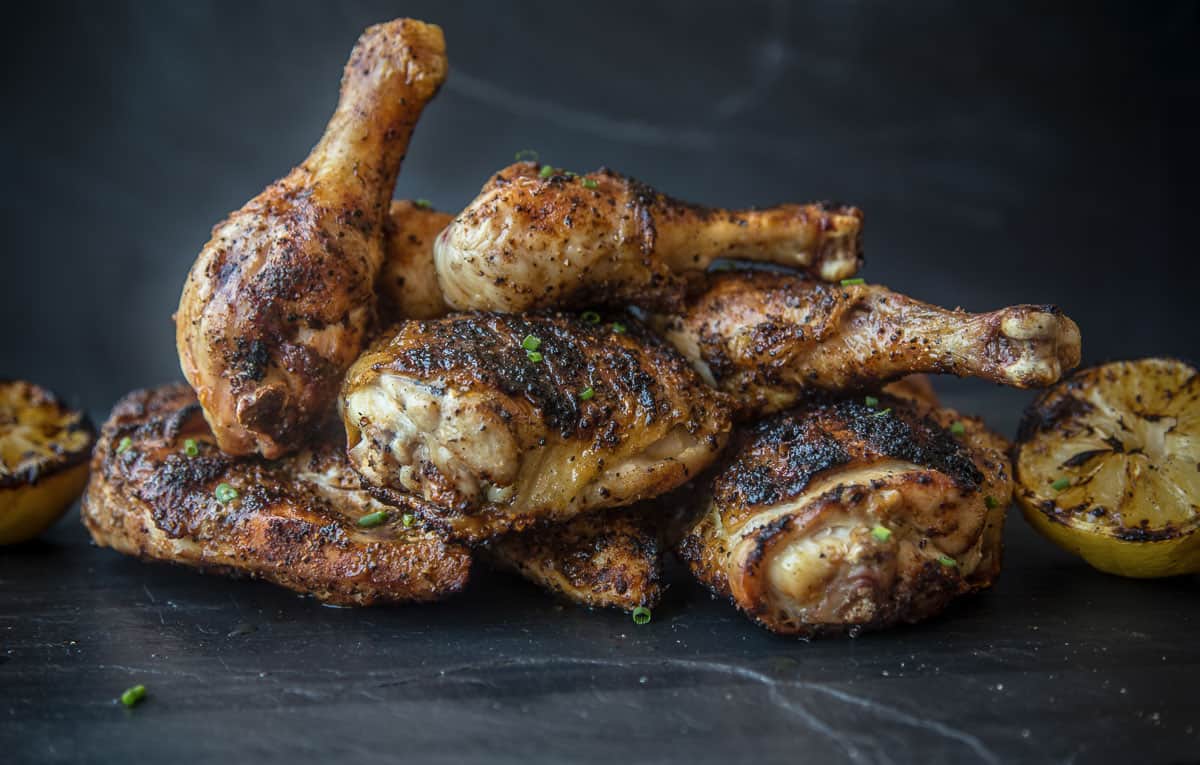
Frequently Asked Questions
First, start with a clean grill grate. Apply a high heat oil to the grill if you would like prior to cooking or heating. As the meat sears, it will reach a sweet spot where it will lift right off the grate. Dirty grates cause sticking, so after every cook, get into the habit of brushing the grill off.
Marinating chicken is personal choice and can add additional flavor. It can be as simple as Italian dressing, or a homemade chicken marinade. Either way, the same cooking technique applies. When marinating chicken, we recommend marinating anywhere from 3-6 hours, using smaller cuts (like cubed chicken pieces, our pounded chicken breasts).
Bone-in chicken holds everything together and, for chicken breasts, acts as a heat shield (acting as a barrier between the meat and the heat source). When possible, we prefer to cook bone-in chicken. If you are opting for boneless, just be aware the meat will likely cook faster than bone-in.
It depends on the individual piece and size. Generally the chicken breasts will cook in 20 – 25 minutes total. Other factors that will increase or decrease chicken cooking time include how hot your grill is, how close to the fire it is, or how much chicken you pack into the grill.

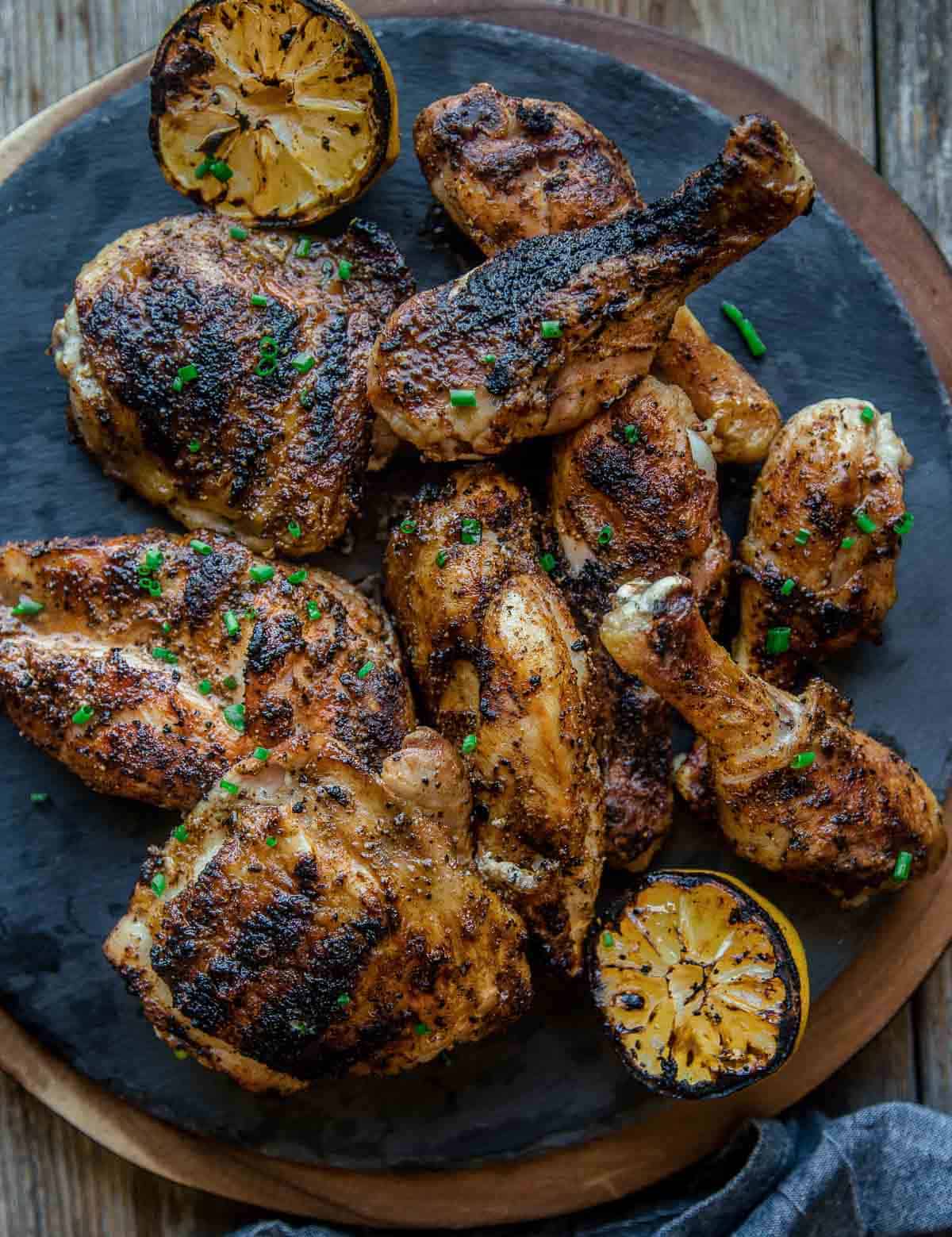
More Grilled Chicken Recipes
- Wine Can Chicken
- Sriracha Sweet Chili Chicken
- Grilled Chicken with a Cranberry Chipotle Citrus Glaze
- Chicken with Cherry Chipotle BBQ Sauce
- Dry Brined Smoked Chicken with Carolina Glaze
- Grilled Chicken with Blackberry BBQ Sauce
- Jerk Chicken
Mary (a certified sommelier) and Sean (backyard pitmaster) are co-authors of the critically acclaimed cookbook, Fire + Wine, and have been curating content for the IACP nominated website Vindulge since 2009. They live in Oregon on a farm just outside Portland.
Tried this recipe? Give us a star rating and we would love to see! Mention @vindulge or use the hashtag #vindulge on all the social media handles. And consider subscribing to our newsletter where we drop all our favorite ideas and inspirations every week.
*This post contains affiliate links for the ThermoWorks Mk4 Digital Thermometer. We only recommend products we use and love! And we use these thermometers use regularly and consider them an integral part of successful grilling.
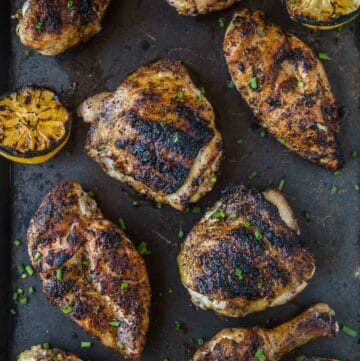
How To Grill The Perfect Chicken
#wprm-recipe-user-rating-6 .wprm-rating-star.wprm-rating-star-full svg * { fill: #ffffff; }#wprm-recipe-user-rating-6 .wprm-rating-star.wprm-rating-star-33 svg * { fill: url(#wprm-recipe-user-rating-6-33); }#wprm-recipe-user-rating-6 .wprm-rating-star.wprm-rating-star-50 svg * { fill: url(#wprm-recipe-user-rating-6-50); }#wprm-recipe-user-rating-6 .wprm-rating-star.wprm-rating-star-66 svg * { fill: url(#wprm-recipe-user-rating-6-66); }linearGradient#wprm-recipe-user-rating-6-33 stop { stop-color: #ffffff; }linearGradient#wprm-recipe-user-rating-6-50 stop { stop-color: #ffffff; }linearGradient#wprm-recipe-user-rating-6-66 stop { stop-color: #ffffff; }
Equipment
Ingredients
- ¼ cup chicken seasoning
- 2 tablespoons extra virgin olive oil
- 2 pieces chicken breasts, bone-in (If boneless then use a kitchen mallet to even out)
- 2 pieces chicken thighs
- 2 pieces chicken legs
Instructions
-
Season: Prior to grilling, pat dry the chicken, coat with olive oil and season liberally. Cover and place back into fridge until ready to grill. For best results, do this one day in advance
-
Prep Grill: Prepare grill for direct/indirect method of cooking, and remove the chicken from the refrigerator. Target 475 to 500 degrees F in the cooking chamber.
-
Grill Direct: Place the chicken pieces over direct heat. Cook each side for approximately 5 minutes, or until you see the desired crust, and then move to indirect heat to finish cooking, turning each piece occasionally.
-
Grill Indirect: Continue cooking until the internal temperature of the breast is 155 degrees F as measured on an instant read thermometer. Pull and let rest for 15 minutes (the internal temperature of the chicken will continue to rise another 5 degrees).
For thighs and legs cook until the internal temperature reaches 175 degrees. Rest 10 minutes then serve.
-
Serve: Serve and enjoy.
Video
Notes
Glaze: If you plan on glazing then do so when the chicken reaches 150 degrees F over direct heat and apply with a silicone brush.
Thighs and Legs: If you are grilling thighs and legs then grill until the internal temperature is 175 degrees F.
Find the perfect wine pairing at the Vindulge Wine Shop
Nutrition
The post How to Grill Perfect Chicken – Every Time appeared first on Vindulge.